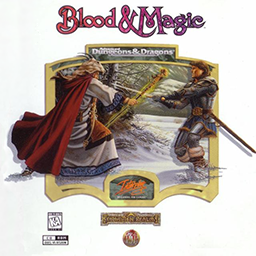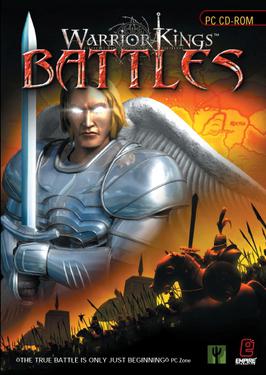
Warhammer 40,000 is a miniature wargame produced by Games Workshop. It is the most popular miniature wargame in the world, and is particularly popular in the United Kingdom. The first edition of the rulebook was published in September 1987, and the tenth and current edition was released in June 2023.

Dominions II: The Ascension Wars is a 4X turn-based, computer strategy game. It was developed by Illwinter Game Design and published by Shrapnel Games. The game was released on November 14, 2003 in North America for Microsoft Windows, Mac OS X and Linux.

Age of Wonders is a 1999 turn-based strategy game co-developed by Triumph Studios and Epic MegaGames, and published by Gathering of Developers.

Master of Magic is a single-player, fantasy turn-based 4X strategy game in which the player plays as a wizard attempting to dominate two linked worlds. From a small settlement, the player manages resources, builds cities and armies, and researches spells, growing an empire and fighting the other wizards.
Warlords is a video game series created by Steve Fawkner, in which role-playing elements are combined with turn-based strategy in a fantasy setting. The series began with Warlords in 1990 and includes three other games, two expansion packs, and several spinoffs.

Warlords IV: Heroes of Etheria is a turn-based strategy video game developed by Infinite Interactive and published by Ubi Soft. It is the fourth in the Warlords series.

Chaos: The Battle of Wizards is a turn-based tactics video game released for the ZX Spectrum in 1985. It was written by Julian Gollop and originally published by Games Workshop. Based on Gollop's 1982 design for a board game / card game hybrid, Chaos received a positive reception and went on to influence various games, including Darwinia and King's Bounty, and spawned a sequel, Lords of Chaos, in 1990.

Greyhawk Wars is a fantasy board wargame that was published by TSR, Inc. in 1991. The game was designed by David Cook as a strategic simulation of the eponymous Greyhawk Wars on the fictional world of Oerth, the World of Greyhawk campaign setting for the Dungeons & Dragons role-playing game.

Blood & Magic is a real-time strategy video game released by Interplay Productions in 1996 which uses the Dungeons & Dragons license.

The Lord of the Rings: War of the Ring is a 2003 real-time strategy game (RTS) developed by Liquid Entertainment and published by Sierra Entertainment, a subsidiary of Vivendi Universal Games. Set in J. R. R. Tolkien’s fictional Middle-earth, it expands upon the events of the War of the Ring as told in his fantasy novel, The Lord of the Rings.
Empire of The Rising Sun (RSN–1995) is a board wargame published originally by Avalon Hill, designed by Bruce Harper with much input by Dave Casper into the naval warfare rules. This is the Pacific War companion game to Advanced Third Reich (A3R), using similar rules, and containing once again a copy of Ultra magazine with a synopsis of the game. A previous version, occasionally discussed in the pages of The General magazine, had been in development the late 1970s, but was never published.

Dominions 3: The Awakening is a fantasy turn-based strategy game created by Illwinter and published in 2006 by Shrapnel Games. It is the third game in the Dominions series, preceded by Dominions: Priests, Prophets and Pretenders and Dominions II: The Ascension Wars. Illwinter's publishing contract with Shrapnel Games expired in November 2012 and Dominions 3 was republished on Desura in late December and soon after on GamersGate. Dominions 3 went through the Greenlight process and was released on Steam in September 2013.

Puzzle Quest: Challenge of the Warlords is a puzzle video game designed by Steve Fawkner for Australian game developer Infinite Interactive and published by D3 Publisher in 2007. The game combines role-playing with tile-matching elements. Taking place in a high fantasy setting, the player moves their character around the game's world and encounters monsters and other enemies to fight so as to gain experience and acquire treasure as in a typical role-playing game. Combat takes place on a board similar to Bejeweled, and by making matches of coloured gems, the combatants can cause damage to their opponents, cast spells, or perform other abilities that affect the flow of the game.

Magic: The Gathering is a video game published by MicroProse in March 1997 based on the collectible card game Magic: The Gathering. It is often referred to as Shandalar after the plane of Shandalar, where the game takes place. The player must travel the land and fight random enemies to gain cards, and defeat five wizards representing the five colors. The player must prevent one color from gaining too much power, and defeat the planeswalker Arzakon, who has a deck of all five colors. Adventure and role-playing elements are present, including inventory, gold, towns, dungeons, random battles, and character progression in the form of new abilities and a higher life point total. An oversized version of Aswan Jaguar was included in the game box.

Vantage Master is a 1997 tactical role-playing game by Nihon Falcom. The game was never released outside of Asia. A sequel, Vantage Master V2, was released in 1998, featuring new maps and adjusted character balance but an unchanged overall game design. The English version of V2 was made available as a free download as of 2002 under the title Vantage Master Online. Another sequel, VM Japan, was released in 2002.
World of Warcraft (WoW), is set in a fictional universe, with its primary setting being the planet of Azeroth. The first expansion, The Burning Crusade, introduced a second planet, Outland. Wrath of the Lich King expanded upon Azeroth and added Northrend, the frigid northern continent of Azeroth, while the next expansion, and Cataclysm, drastically changed various other continents by destroying some and unveiling new ones. The next expansion, Mists of Pandaria, added Pandaria, the southern continent previously hidden behind a perennial mist cover. Warlords of Draenor introduced the planet of Draenor, a version of Outland in a different timeline before its partial destruction. The Legion expansion took adventurers to the Broken Isles, an island chain near the Maelstrom in the middle of the Great Sea, and the damaged planet Argus, the headquarters of the Burning Legion. The seventh expansion, Battle for Azeroth, added two new island continents to the center of Azeroth: Kul Tiras and Zandalar. The latest expansion, Shadowlands, introduced the eponymous Shadowlands, a realm composed of five major zones: Bastion, Maldraxxus, Ardenweald, Revendreth, and the Maw.

Warrior Kings: Battles is a real-time strategy video game developed by British studio Black Cactus and published by Empire Interactive in Europe and co-published with Strategy First in North America. It is a sequel to the 2002 game Warrior Kings and was released March 21, 2003 in Europe and September 30, 2003 in North America.

Universe: The Role-Playing Game of the Future is a science fiction role-playing game published by Simulation Publications, Inc (SPI) from 1981 to 1983. It was praised for its innovative and tightly organized rules for such sci-fi RPG concerns as generating planets, applying character skills to in-game situations, and resolving the initial moments of alien encounters; however, it was also criticized for its cumbersome encounter/combat system and its lack of compelling background material. Universe was also noted for its "striking" Interstellar Display, a poster-sized, astronomically accurate map of all stars within 30 light-years of Earth.
Illyriad is a free to play massively multiplayer online persistent browser-based strategy game developed by the UK software company Illyriad Games Ltd, the company's first full online strategy game, first released in beta in 2010, and launched in 2011.

Warlock: Master of the Arcane is a 4X turn-based strategy video game developed by 1C:Ino-Co Plus and published by Paradox Interactive. It was released for Microsoft Windows on 8 May 2012. A sequel, Warlock II: The Exiled, was released in 2014.















